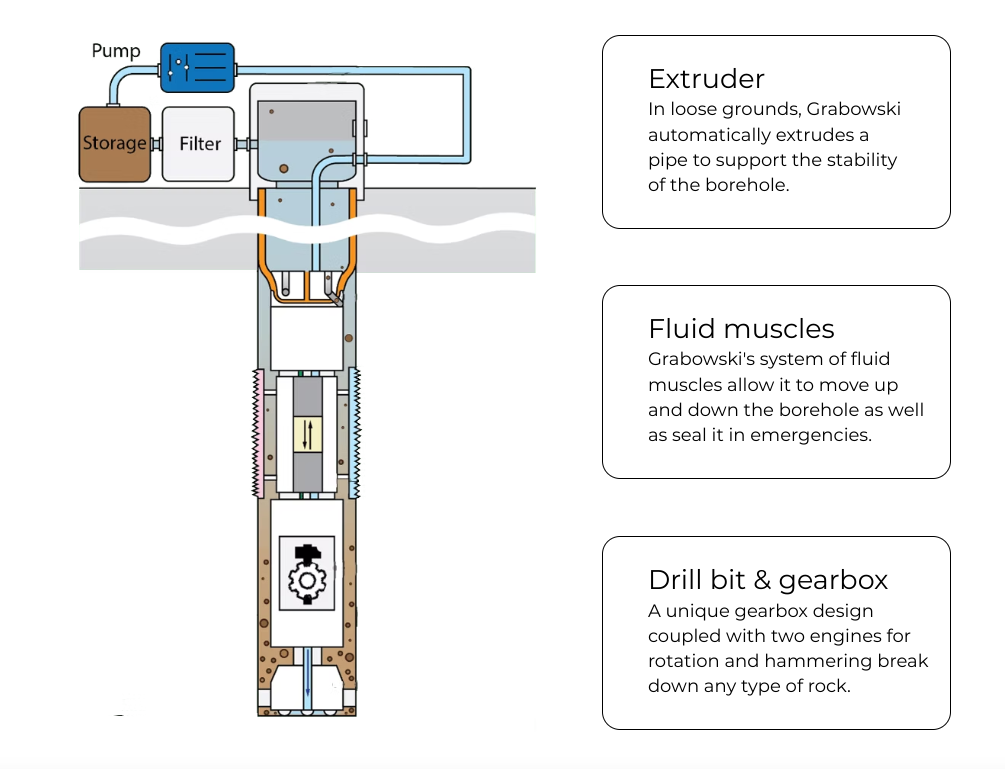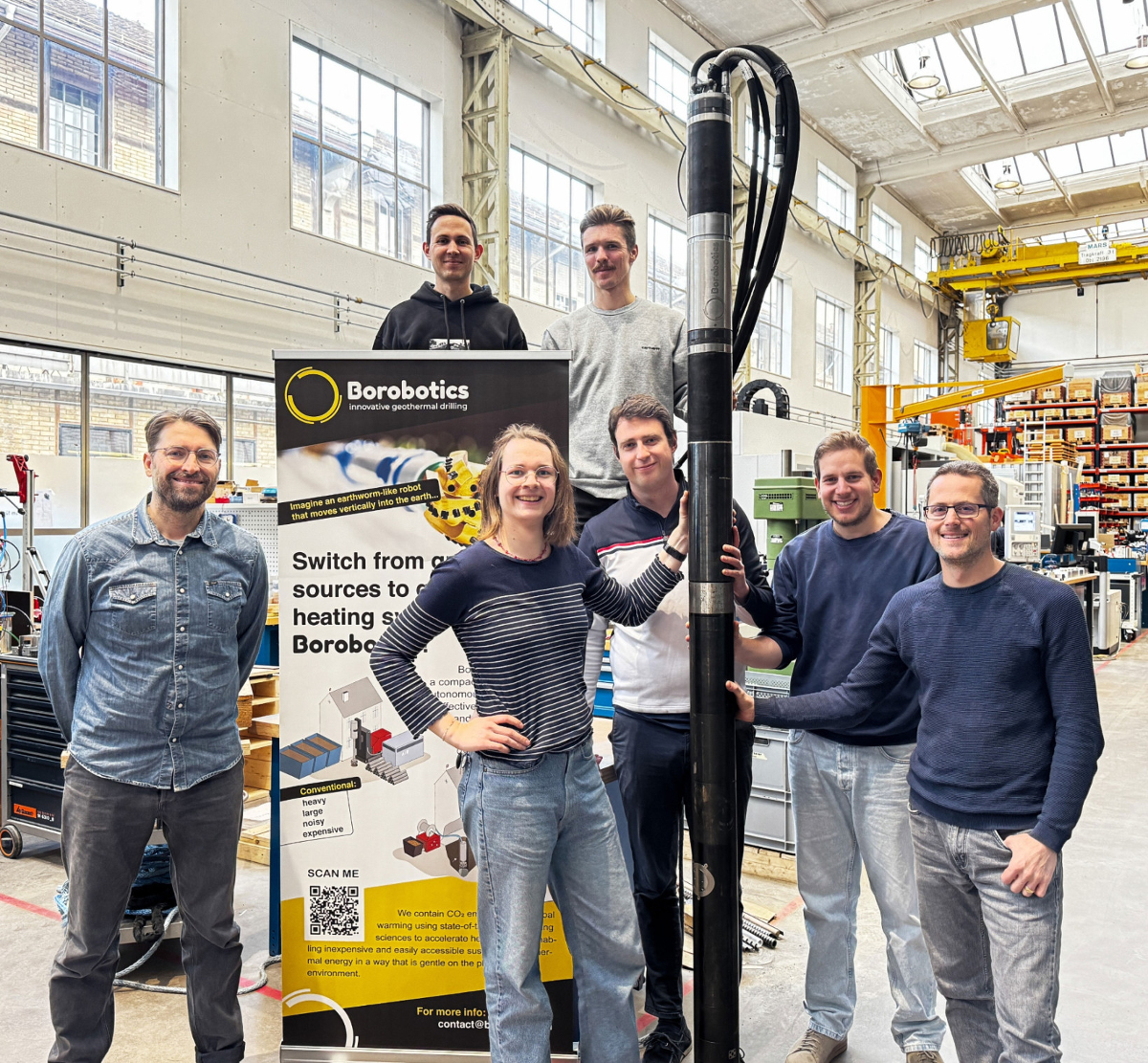
Sign up for daily news updates from CleanTechnica on email. Or follow us on Google News!
In much of Europe, the temperature of the Earth 250 meters (820 feet) below the surface is a constant 14º C (57º F). That makes it an ideal temperature for ground source heat pumps — cool enough to conquer heat in the summer and warm enough to heat any building in the winter. But drilling down far enough to access that temperate zone can be costly and often requires large drilling rigs powered by diesel engines. Borobotics is a Swiss company that has invented an autonomous mini drilling machine that is just 13.5 cm wide and 2.8 meters long (5½ inches by 9¼ feet). Setting it up requires less that 8 square meters (86 square feet) of space, which means it needs no more space than the typical garden or parking space.
Borobotics calls its mini boring machine the “world’s most powerful worm” and claims it will make harnessing geothermal energy less expensive and more accessible for everyone. The drill is easy to install and uninstall and operates completely autonomously. Best of all, it operates on normal household current (which in Switzerland is 240 volts). While it drills, it tracks its every movement and steers itself downwards in a straight trajectory. Here’s a graphic that shows how it works.

Sensors in the mini boring machine allow it to detect which type of material it’s boring through. If it encounters water or methane on its way down, the robot worm automatically seals the borehole shut. In loose soil, it can create its own sheathing to support the bore hole. It does have a few drawbacks. It is clearly not as powerful as a bigger diesel-powered drilling rig and its maximum drilling depth is 500 meters — about 1600 feet. But that’s more than enough to tap the burgeoning demand for geothermal heat pumps. Those devices use a network of subterranean pipes to transfer water at a constant temperature from below the ground for heating and cooling.
Borobotics & Energy Consumption
Why is this important? Because heating and cooling buildings accounts for half of global energy consumption, the majority of which comes from burning fossil fuels like natural gas. To curb those emissions, the EU has committed to installing 43 million new heat pumps between 2023 and 2030, as part of the bloc’s €300 billion REPowerEU plan. Because heat pumps use electricity instead of fossil fuels to transfer heat or cold air, they are up to three times more efficient than an equivalent gas boiler. If the electricity they use comes from a renewable energy source, so much the better.
The EU supports both geothermal and air source heat pumps, but the latter dominate the market thanks to lower costs and easier installation. “The potential of geothermal heat pumps to decarbonise Europe is substantial, as long as the cost comes down,” Torsten Kolind, managing partner at Underground Ventures, tells TNW. “The minute that happens, the market is open.” The Borobotics system is designed to make ground source heat pumps more price competitive thanks to lower installation costs.
Moritz Pill, co-founder of Borobotics, told TNW that because of the small size of its drill, it is “very resource efficient” to produce and maintain. He added, “A small team arrives at a site with a Sprinter van containing everything necessary to drill. They set the drill in half a day and from then on it works autonomously.” Pill predicts that one or two people will be able to handle up to 13 drill sites simultaneously. If that proves to be correct in practice, that means drilling companies could install more systems in less time.

Despite the apparent potential, Borobotics is a young company that is just getting started. It has developed its first working prototype; now it needs to build a business. Founded in 2023, it has just received its first major funding and expects to test the robot in real conditions this year.
IEA Report On Geothermal Energy
The timing couldn’t be better. In December, the International Energy Agency released its first report on geothermal energy in over 10 years. In that report, the IEA predicted geothermal could account for up to 15% of global energy demand by 2050, up from just 1% today. Previously, geothermal projects were largely government led and confined to volcanically active regions like Iceland or New Zealand where hot water bubbles at or near the surface. But the next wave of installations will likely be led by startups like Borobotics armed with state of the art technology that allows them to dig deeper and more efficiently.
Geothermal energy startups attracted $650 million in venture capital funding in 2024, the highest value ever recorded, according to Dealroom data. One of those is US-based Fervo Energy, backed by Bill Gates’ Breakthrough Energy Ventures. Google has already plugged into Fervo’s geothermal plant in Nevada to power one of its data centers. Another upstart is Canada’s Eavor, which is currently building a giant underground “radiator” in Germany that could heat an entire town. “The problem has always been geology and economics, but the advances of startups like Fervo and Eavor in recent years have changed the game,” says Kolind.
While US startups are leading the pack, Europe is well poised to compete. “Europe has excellent geothermal subsurface conditions, and, unlike America, it also has a strong tradition for district heating,” he said, adding he believes it’s only a matter of time before Europe’s investors and policymakers go all-in on geothermal tech. “Unlike natural gas and coal, it is fossil-free. Unlike wind and solar, it is always-on. And unlike nuclear energy, it is geopolitically benign.”
Two years ago, Dandelion, a Google spinoff, was set to enter the residential geothermal energy space, but its technology still relied on conventional drilling techniques that were too cumbersome for many applications. In the final analysis, its systems, while technically sophisticated, were more expensive than the market was ready for and the business languished. Part of the problem is that ground source heat pumps cost more than air source heat pumps, which extends the return on investment timeline enough that many homeowners were uncomfortable with the economics.
Companies like Fervo Energy are experimenting with drilling down 10,000 feet or more to where the temperature of the Earth is hot enough to make steam to spin electrical generators. What Borobotics is doing is a much milder form of harvesting energy from the Earth. Many readers may recall growing up in homes where the basement was the coolest part of the house when temperatures soared in the summer. Some adventurous people have built homes that are partially underground to insulate their living spaces from winter cold and summer heat.
If Borobotics is successful at creating a business model, the result could be a powerful tool for lowering the demand for electricity worldwide. As carbon dioxide emissions continue to rise, that would be welcome news.
Hat tip to Dan Allard.
Chip in a few dollars a month to help support independent cleantech coverage that helps to accelerate the cleantech revolution!
Have a tip for CleanTechnica? Want to advertise? Want to suggest a guest for our CleanTech Talk podcast? Contact us here.
Sign up for our daily newsletter for 15 new cleantech stories a day. Or sign up for our weekly one if daily is too frequent.
CleanTechnica uses affiliate links. See our policy here.
CleanTechnica’s Comment Policy




